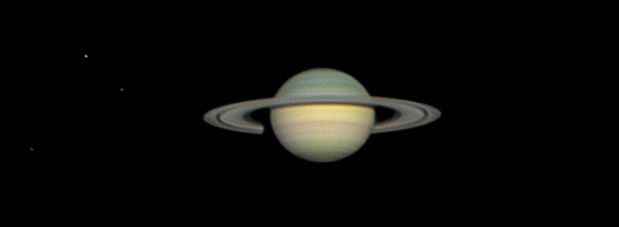Saturn
Seeing conditions could be slightly better, but still I'm pleased with the results.
DMK21AU04.AS
Meade Starfinder 10
Seeing conditions could be slightly better, but still I'm pleased with the results.
My first Saturn of this season. Imaged during pretty good seeing conditions. Saturn was at about 37 degrees altitude.
Another O-OSC image of Saturn also showing tethys just above the ring-plane to the right.
The luminance frames were captured through an orange filter and were taken with my Toucam Pro II camera. The one shot colour data is from the spc900nc webcam. In total I stacked about 2000 luminance frames and 1000 osc frames in Registax.
The two images were combined and further processed in Photoshop.
South is up.
Another image of Saturn during some good seeing conditions (visually I could observe Saturn at 570x magnification without a problem! It looked fantastic. You could see several bands + colouration on the surface, and you could see 'through' the rings all the time. The rings were also clearly visible in front of the planet at all times. )
The Toucam Pro II camera (see equipment) showed some unfamiliar noise problems; at 5 fps there were wavy lines visible throughout all the frames, at 10 fps the lines got 'smeared' away due to the compression of the camera kicking in at the higher frame rates. But something was definately wrong, and there is no doubt in my mind that the image could have been better (I really need to save up some cash for a mono DMK camera)
Anyways, the image still turned out very nice. This is probably because of the good seeing and high amount of frames I stacked for this image.
An infrared filter combined with the 840k camera was used to gather the luminance frames; 6000 in total, of which I stacked 3000. I couldn\'t detect any surface features in shorter recordings, so I ignored the planets rotation speed a bit, and simply stacked a larger amount of frames.
The trusty spc900nc (which is still working fine) was used to gather the colour data (combined with a uv/ir-blocking filter of course). The blue and red channels were not half as good as the green channel, but luckily that didn\'t really matter for the final image.
Registax v4 was used to stack the images, and Photoshop CS3 was used to combine the colour and luminance data, and neaten things up a bit.
Here is an animation of Rhea passing in front of Saturn. Rhea is visible in the first few frames just on the left edge of the planet. A storm is also visible just above the rings, rotating about as fast as Rhea's shadow.
The animation consists of 17 pictures, each a stack of about 1000 frames. The luminance data was taken using the 840k webcam (see equipment) combined with several different filters (I was experimenting a bit). The colour information was taken with the SPC900NC webcam.
Images were stacked in Registax, and further processed in Photoshop.
My first 'decent' image of Saturn this season. The rings are getting very small!
There were some clouds in the sky, but I managed to shoot this image between the clouds. Seeing was average.
The image is an Ir-RGB image, where I used an infrared pass filter with my b/w Toucam Pro II 840k for luminance, and a normal RGB-webcam (SPC900NC) combined with an UV/IR-cut filter to get the color information.
In total I used about 1500 frames for Luminance and 500 frames for RGB. The image was stacked in Registax and combined and further processed in Photoshop CS3. The image has been resized to 75% to make it look a bit smoother.
L: 1200/2400 frames (840k, orange filter)
RGB: 500/1100 frames (spc900nc, uv/ir-block filter)
The storm is back, but it looks like there is more than one.
The storm is back, but it looks like there is more than one.
This is an animation of the storm and three of Saturns moons. From left to right: Dione, Tethys and Rhea.
The animation consists of nine strongly processed movies taken between 20:17 and 20:44 (UTC). The moons were present in the original images, but were very faint, so I had to make them a bit brighter.

From left to right: Dione, Rhea, Thethys and Saturn.
L: 1800/4100 frames. Imaged with uv/ir block filter and a simple orange filter (840k)
RGB: 500/1100 frames. Imaged with UV/IR-block (spc900nc)
L: 700/2200 frames (840k, with UV/IR-block filter)
RGB: 300/1000 frames (spc900nc, with UV/IR-block filter)
A storm is visible on the surface of Saturn.